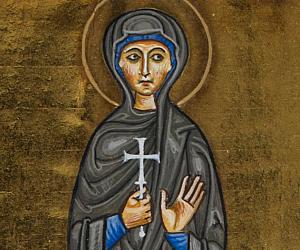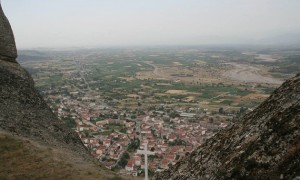The God of the New Testament in the Old Testament (part 5)
4 May 2017“Then Nebouchodonosor was filled with anger, and the appearance of his face was distorted against Sedrach, Misah and Abdenago. And he said that the furnace should be stoked up sevenfold until it would be heated completely and told men, strong in strength, after they had bound Sedrach, Misah and Abdenago, to throw them in the fire… And they were walking around in the middle of the flames, singing hymns to God and blessing the Lord… But the angel of the Lord came down into the furnace… and shook the flame of the fire out of the furnace and made the inside of the furnace as though a moist breeze were whistling through. And the fire did not touch them at all and caused them no pain or distress… And Nebouchodonosor heard them singing hymns and was astonished. And he rose up in haste and said to his nobles, “Was it not three men we threw bound into the middle of the fire?”…”Here I see four men unbound and walking in the middle of the fire… and the appearance of the fourth is like the son of God”. (Daniel 3: 19-20; 49-50; 91-92 [LXX])
Of all Old Testament narratives, Daniel 3 is undoubtedly the most contentious. There is, first of all, a significant difference between the Septuagint Daniel and the Hebrew text. Chapter 3 of the Septuagint is considerably longer, and contains what is known as the “Song of the Three Children”, and also mentions “The Angel of the Lord” descending into the fiery furnace. But let us leave aside the debate about which text one should use. For the Orthodox, the authoritative text is the Septuagint, full stop. The arguments made against the Septuagint by some Protestant Christians that the only texts that are divinely inspired are those which are to be found in the Hebrew canon (though the Hebrew Old Testament was not canonised until the 2nd century A.D.) are nonsensical. The Septuagint was not only used by the Jews of the Dispersion between around the 2nd Century B.C. and the 2nd Century A.D.; it has been the Christian Old Testament since the beginning of the apostolic era. All quotations from the Old Testament in the New are from the Septuagint. If we believe that the New Testament is divinely inspired, then surely the Septuagint which is quoted in the New Testament must also be divinely inspired. Furthermore, because the Septuagint was from the very beginning the Christian Old Testament, all patristic commentaries and hymns are based on the Septuagint.
But the most contentious passage in Daniel is this: “Here I see four men unbound and walking in the middle of the fire…and the appearance of the fourth is like the son of God”. Many translations read: “like a son of the gods” instead of “son of God”. There are two arguments for this translation:
1. Nebouchodonosor was a pagan and would not have known anything about the Son of God, and therefore what he must have said is “a son of the gods”.
2. The original Aramaic text reads “gods”, not “God”.
The problem with the first argument is two-fold. First of all, many Christians read Scripture as a work of history rather than a work of theology. By this I do not mean that Scripture is all myth and legend, and that there is nothing historically accurate about its contents; I mean that we are not to read Scripture with the mind of an historian which bases valid interpretation on timelines, literary sources, archaeology and physical evidence. This is significant for our subject, because if we read Daniel as a work of theology, then we have to ask ourselves: “Is it not possible that the author of Daniel is making a theological point with this statement, “son of God”? We must also ask: “Is it not possible that Nebouchodonosor was divinely inspired to say what he said?” Some Christians argue that since Nebouchodonosor was a pagan and not a prophet of God, this is not possible. They would do well to remember the narrative concerning Balaam and the Angel of the Lord in Numbers 22, when God speaks through Balaam’s donkey. If God can speak through a dumb animal, then can He not speak through a pagan if He so chooses?
Secondly, is it really impossible that Nebouchodonosor did in fact know about the Son of God? As we saw in my previous article (The Angel of the Lord), the notion of a plurality in the Godhead was not alien to the prophets of the Old Testament. The Angel of the Lord, while subordinate to God, was recognised as God Himself (Genesis 16, Genesis 32, Exodus 3, Exodus 23, Judges 2, Judges 6, Judges 13. The “Spirit” of God is also mentioned in the Hebrew Scriptures (Genesis 1:1, Genesis 41:38, Numbers 11:29, 1 Kingdoms 10:6, Psalm 50:13, Joel 2:28). While we do not find the clear New Testament definition of God as Father, Son and Holy Spirit, the notion of one Godhead in a plurality of persons permeates the Old Testament Scriptures. But is it possible that the pagan king, Nebouchodonosor, also knew about the Son?
In Daniel 3 we read that Nebouchodonosor ordered that “some of the children of Israel” should be brought to teach the “learning and the tongue of the Chaldeans”. Among them were Daniel, Hananiah, Mishael, and Azariah, whose names were quickly changed to Belteshazzar, Shadrach, Meshach, and Abednego. In Daniel 2 we read that Nebouchodonosor had a dream and there was no one who could to tell him its meaning, but “the secret was revealed to Daniel in a night vision” (Dan. 2:19). Daniel is then brought before the king to interpret his dream. Daniel says that “there is a God in heaven that reveals secrets, and makes known to King Nebouchodonosor what shall be in the latter days.” (Dan. 2:28). Daniel continues, “You, O King, are a king of kings: for the God of heaven has given you a kingdom, power, and strength, and glory” (Dan. 2:37). Clearly the notion of one God was not foreign to Nebouchodonosor, and if it was, he was certainly now being introduced to the idea by Daniel. In response, Nebouchodonosor says: “Truly, your God is a God of gods, and a Lord of kings, and a revealer of secrets” (Dan. 2:47). It is therefore not impossible that Daniel had initiated Nebouchodonosor into the mystery of the God of his Fathers.
The second argument against the Septuagint translation, “son of God”, in Daniel 3 is that in the original Aramaic text, “son of God” reads “bar-Elahin”, bar meaning ‘son’, and Elahin being the plural for ‘God’; and so it literally reads, “Son of Gods”. This argument, however, does not stand up to scrutiny when one considers that the Hebrew word for God (Elohim) is also plural; as is the Hebrew word for Lord (Adonai). In fact, this only further supports the argument that the Old Testament prophets did indeed know that there was more to God than the person of the Father.
When we consider all the manifestations of the Angel of the Lord which we examined in my previous articles, what makes Daniel 3 particularly interesting from a theological perspective is that this is the first time we hear the same Angel of the Lord described as “the Son of God”. The Greek patristic analysis of the fourth person in the furnace is clear: the Angel of the Lord who came down into the furnace was indeed the pre-incarnate Christ:
“He who delivered the Young Men from the furnace, becoming man suffers as a mortal, and through suffering he clothes the mortal with the glory of incorruption: the only blessed and most glorious God of our fathers”. (7th Ode of the Canon for Pascha)
“The Offspring of the Mother of God saved the holy children in the furnace. He who was then prefigured has since been born on earth, and he gathers all creation to sing: O all you works of the Lord, praise the Lord and exalt Him above all for ever”. (8th Ode of the Katavasia for the Mother of God)
“The all-powerful Angel of God revealed to the Children a flame that brought refreshment to the holy while it consumed the ungodly. And He made the Theotokos into a life-giving fount, gushing forth to the destruction of death and to the life of those that sing: ‘We who have been delivered praise the one and only Creator and exalt Him above all forever’.” (8th Ode of the Katavasia for the Dormition of the Mother of God)
“O Word of God who in the midst of the fire dropped dew upon the children as they discoursed on things divine, and who took up your dwelling in the pure Virgin: we praise you as with piety we sing: Blessed are you, O God of our fathers”. (7th Ode of the Katavasia for the Meeting of the Lord)
“The Babylonian furnace, as it poured forth dew, foreshadowed a marvellous mystery: how the Jordan should receive in its streams the immaterial fire, and should encompass the Creator, when He was baptised in the flesh. Bless Him O people and exalt Him above all for ever”. (8th Ode of the Katavasia for the Theophany)













